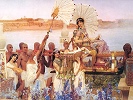
Sacred Texts Legends and Sagas Index Previous Next
Buy this Book on Kindle


The Myth of the Birth of the Hero, by Otto Rank, [1914], at sacred-texts.com
FROM the mass of chiefly biographic hero myths, we have selected those that are best known and some that are especially characteristic. 1 These myths will be given in abbreviated form, as far as relevant for this investigation, with statements concerning the sources. Attention will be called to the most important and constantly recurring motifs by the use of italic type.
Probably the oldest transmitted hero myth in our possession is derived from the period of the foundation of Babylonia (about 2800 B.C.) and concerns the birth history of its founder, Sargon the First. 2 The literal translation
of the report--according to the mode of rendering, it appears to be an original inscription by King Sargon himself--is as follows:
14:1 Attention has been drawn to the great variability and wide distribution of the birth myths of the hero by the writings of Bauer, Schubert, and others referred to in the preceding pages. The comprehensive contents of the myths and their fine ramifications have been especially discussed by Hüsing, Lessmann, and other representatives of the modern trend.
14:2 Innumerable fairy tales, stories, and poems of all times, up to the most recent dramatic and novelistic literature, show very distinct individual main motifs of this myth. The exposure-romance appears in the late Greek pastorals--Heliodorus' Aethiopica, Eustathius' Ismenias and Ismene, and Longus' story of the two exposed children, Daphnis and Chloe. The more recent Italian pastorals are likewise very frequently based upon the exposure of children, who are raised as shepherds by p. 15 their foster parents, but are later recognized by the true parents, through identifying marks received at the time of their exposure. To the same set belong the family history in Grimmelshausen's Limplizissimus (1665), in Jean Paul's Titan (1800), as well as certain forms of the Robinson stories and Cavalier romances (compare Würzbach's Introduction to Hesse's edition of Don Quixote).